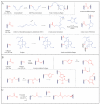The Use of Collagen-Based Materials in Bone Tissue Engineering
- PMID: 36835168
- PMCID: PMC9963569
- DOI: 10.3390/ijms24043744
The Use of Collagen-Based Materials in Bone Tissue Engineering
Abstract
Synthetic bone substitute materials (BSMs) are becoming the general trend, replacing autologous grafting for bone tissue engineering (BTE) in orthopedic research and clinical practice. As the main component of bone matrix, collagen type I has played a critical role in the construction of ideal synthetic BSMs for decades. Significant strides have been made in the field of collagen research, including the exploration of various collagen types, structures, and sources, the optimization of preparation techniques, modification technologies, and the manufacture of various collagen-based materials. However, the poor mechanical properties, fast degradation, and lack of osteoconductive activity of collagen-based materials caused inefficient bone replacement and limited their translation into clinical reality. In the area of BTE, so far, attempts have focused on the preparation of collagen-based biomimetic BSMs, along with other inorganic materials and bioactive substances. By reviewing the approved products on the market, this manuscript updates the latest applications of collagen-based materials in bone regeneration and highlights the potential for further development in the field of BTE over the next ten years.
Keywords: bone substitute materials; bone tissue engineering; collagen; collagen modifications; composite bone scaffolds.
Conflict of interest statement
The authors declare no conflict of interest.
Figures









Similar articles
-
Biomimetic composite scaffolds containing bioceramics and collagen/gelatin for bone tissue engineering - A mini review.Int J Biol Macromol. 2016 Dec;93(Pt B):1390-1401. doi: 10.1016/j.ijbiomac.2016.06.043. Epub 2016 Jun 15. Int J Biol Macromol. 2016. PMID: 27316767 Review.
-
Preparation of a biomimetic composite scaffold from gelatin/collagen and bioactive glass fibers for bone tissue engineering.Mater Sci Eng C Mater Biol Appl. 2016 Feb;59:533-541. doi: 10.1016/j.msec.2015.09.037. Epub 2015 Sep 11. Mater Sci Eng C Mater Biol Appl. 2016. PMID: 26652405
-
Recent trends in bone tissue engineering: a review of materials, methods, and structures.Biomed Mater. 2024 May 29;19(4). doi: 10.1088/1748-605X/ad407d. Biomed Mater. 2024. PMID: 38636500 Review.
-
Biomimetic component coating on 3D scaffolds using high bioactivity of mesoporous bioactive ceramics.Int J Nanomedicine. 2011;6:2521-31. doi: 10.2147/IJN.S25647. Epub 2011 Oct 21. Int J Nanomedicine. 2011. PMID: 22072886 Free PMC article.
-
Development of a bioactive porous collagen/β-tricalcium phosphate bone graft assisting rapid vascularization for bone tissue engineering applications.J Biomed Mater Res A. 2018 Jan;106(1):73-85. doi: 10.1002/jbm.a.36207. Epub 2017 Sep 26. J Biomed Mater Res A. 2018. PMID: 28879686
Cited by
-
Exosome-Laden Hydrogels as Promising Carriers for Oral and Bone Tissue Engineering: Insight into Cell-Free Drug Delivery.Int J Mol Sci. 2024 Oct 15;25(20):11092. doi: 10.3390/ijms252011092. Int J Mol Sci. 2024. PMID: 39456873 Free PMC article. Review.
-
Challenges and Pitfalls of Research Designs Involving Magnesium-Based Biomaterials: An Overview.Int J Mol Sci. 2024 Jun 5;25(11):6242. doi: 10.3390/ijms25116242. Int J Mol Sci. 2024. PMID: 38892430 Free PMC article. Review.
-
Chitosan, Gelatin, and Collagen Hydrogels for Bone Regeneration.Polymers (Basel). 2023 Jun 21;15(13):2762. doi: 10.3390/polym15132762. Polymers (Basel). 2023. PMID: 37447408 Free PMC article. Review.
-
Growth Factor Delivery Using a Collagen Membrane for Bone Tissue Regeneration.Biomolecules. 2023 May 10;13(5):809. doi: 10.3390/biom13050809. Biomolecules. 2023. PMID: 37238679 Free PMC article. Review.
-
Viability of Collagen Matrix Grafts Associated with Nanohydroxyapatite and Elastin in Bone Repair in the Experimental Condition of Ovariectomy.Int J Mol Sci. 2023 Oct 29;24(21):15727. doi: 10.3390/ijms242115727. Int J Mol Sci. 2023. PMID: 37958710 Free PMC article.
References
-
- Miron R.J., Sculean A., Shuang Y., Bosshardt D.D., Gruber R., Buser D., Chandad F., Zhang Y. Osteoinductive potential of a novel biphasic calcium phosphate bone graft in comparison with autographs, xenografts, and DFDBA. Clin. Oral Implant. Res. 2016;27:668–675. doi: 10.1111/clr.12647. - DOI - PubMed
-
- Li Y., Liu Y., Li R., Bai H., Zhu Z., Zhu L., Zhu C., Che Z., Liu H., Wang J., et al. Collagen-based biomaterials for bone tissue engineering. Mater. Des. 2021;210:110049. doi: 10.1016/j.matdes.2021.110049. - DOI
Publication types
MeSH terms
Substances
Grants and funding
- 13GW0400A/Federal Ministry of Education and Research
- 13GW0400C/Federal Ministry of Education and Research
- 13GW0430B/Federal Ministry of Education and Research
- NA/State Ministry of Baden-Württemberg for Economic Affairs, Labor, and Tourism
- 449916462/German Research Foundation (Deutsche Forschungsgemeinschaft, DFG)
LinkOut - more resources
Full Text Sources
Research Materials

